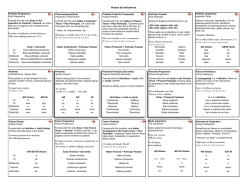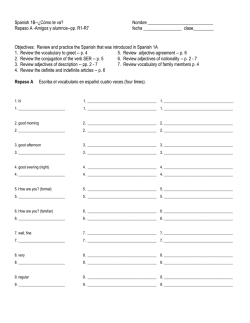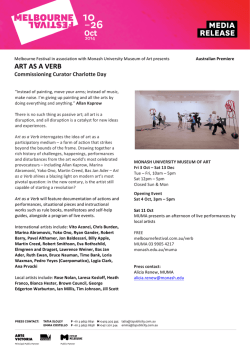
Use of the impersonal pluralized verb haber in Caribbean varieties
Use of the impersonal pluralized verb haber in Caribbean varieties of Spanish Angelica Hernandez The University of Western Ontario According to prescriptive grammars of Spanish, impersonal verbs can only be conjugated in the third person singular. One such verb is the Spanish verb haber, ‘there is’. However, we often find pluralized forms of this verb being used by native speakers of Spanish, as in 1: 1. Habia-n muchas personas. There were-PL many persons. This phenomenon, known as ‘the pluralization of haber’ has been studied in several countries of Central and Latin America, and is reported to be increasing in frequency despite being stigmatized by speakers of higher education levels (Diaz-Campos 2003, De Mello 1994). A study by Claes (2014) explains this phenomenon as a result of a change in the function of the complement of the verb. When the verb haber is pluralized, the direct object of the verb is used as the subject. This causes pluralization of the verb when the direct object is plural since it creates subject-verb agreement. Claes argues that this phenomenon shows a linguistic change in progress in the language where a personal form of impersonal haber emerges. This conclusion, however, is not shared by all. Another opinion relating to this phenomenon is expressed by Quintanilla-Aguilar (2009) who argues that pluralized forms of impersonal haber can be traced back to the 18th century and represent simply variation that has been and will remain stable. In this study I look at the effect that certain sociolinguistic parameters like age, sex and socioeconomic status have on the frequency of use of plural forms of the impersonal verb haber. This can allow us to see whether the phenomenon shows characteristics of a linguistic change in progress or not (Labov 2001). For this project I use three corpora representing the Caribbean varieties of Spanish: One corpus composed of 30 interviews from Holguín (Tennant et al. 2006), a corpus composed of 29 interviews from La Habana, Cuba ((Gonzales Mafud et al. 2010), and a corpus composed of 23 interviews from San Juan, Puerto Rico (Morales and Vaquero 1990). Using this data I compare the frequency of use of pluralized impersonal haber according to age (Younger N=43; Older N=42), education level (Higher education N=16; Lower education N =14), and sex (Men, N=43; Women, N=42) of the participants. Furthermore, I also briefly look at the effect that other linguistic factors have on the use of this phenomenon in Caribbean Spanish: (+ human) trait of the direct object, the tenses of the verb most frequently pluralized, and the distance and position of the SN (direct object) relative to the verb in the sentence. Some preliminary results show that the factor most strongly predicting the use of plural forms of haber is the educational level of the speaker. Furthermore, the older group uses plural forms more often than the younger group, but this could also be due to a confounding effect with educational level. Further investigation is required to tease apart the effects of these different factors. I also find in the data strong indicators of stigmatization of pluralized haber forms. This may indicate that the stigma tied to the phenomenon may be having an effect on the progression of the linguistic change. Bibliography Claes, Jeroen. 2014. A cognitive construction grammar approach to the pluralization of presentational haber in Puerto Rican Spanish. Language Variation and Change, 26(02): 219–246. doi:10.1017/S0954394514000052 De Mello, George. (1994). Pluralizacion del verbo ‘haber’ impersonal en el español hablado culto. Studia Neophilologica, 66: 77-91. Díaz-Campos, Manuel. 2003. La pluralizacion del verbo haber en dos areas dialectales de hispanoamerica. Anuario de Lingüística Hispánica, XV (XVI): 235-245 González Mafud, Ana María., Marisela Pérez Rodríguez, Maryalis Perdomo Carmona and Gretel Gutiérrez Fuentes. 2010. Muestras del habla culta de La Habana. Editorial UH. La Habana, Cuba. Jose Roberto Alexander Quintanilla-Aguilar. 2009. La (des)pluralizacion del verbo haber existencial en el español salvadoreño: ¿un cambio en progreso? Doctoral thesis. The University of Florida. Labov, William. 2001. Principles of linguistic change. Vol. 2. Social factors. Oxford:Blackwell. Morales, Amparo and Maria Vaquero. 1990. El habla culta de San Juan. Materiales para su estudio. Editorial de la Universidad de Puerto Rico. Rio Piedras, Puerto Rico. Tennant, Jeff, David Heap and Ana Faure. 2006. The Holguín Cuban Spanish corpus. Communication, Hispanic Linguistic Symposium. University of Western Ontario, London, Ontario.
© Copyright 2025


